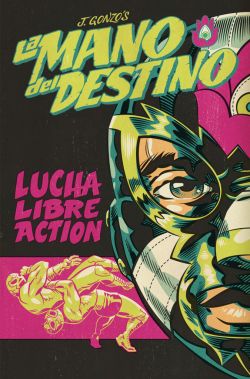|

|
J. GONZO
 SEND THIS TO A FRIEND! SEND THIS TO A FRIEND!
DF Interview: J. Gonzo brings Lucha Libre culture to comics in the ‘La Mano del Destino’ TPB By Byron Brewer La Mano del Destino tells the tale of a once-champion luchador who, after being betrayed by his friends and unmasked in the ring, agrees to a Faustian bargain with a mysterious promoter. He gains a new power and the identity of La Mano del Destino in order to exact revenge upon his betrayers. Set in a swanky 1960s Mexico where Lucha Libre is intrinsically woven into all aspects of society, this tale winds its way through the machinations and motivations of all types who inhabit this unique setting. Can La Mano del Destino get his revenge while remaining the champion he knows himself to be? Meso-American myth, Silver-Age storytelling, and high-flying Lucha Libre action converge to tell this epic story of vengeance and destiny! All from artist/writer J. Gonzo, this TPB collects the original indie run of La Mano del Destino #1-6 plus a whole lot more! As pro wrestling and Lucha Libre fans, DF was honored to speak with creator J. Gonzo upon the announcement of this TPB collection from Top Cow and Image Comics. Dynamic Forces: Gonzo, as a long-time pro wrestling and Lucha Libre fan, this is a trade paperback that I am really looking forward to. I never had the opportunity to read La Mano del Destino on the indie circuit, so it will be a pleasure to see it collected in this softcover as it hits direct market. Before we dive into the book, tell readers about this passion project of yours… how you came up with it, and executed the original six issues as writer and artist. J. Gonzo: As a Chicano who grew top in LA in the ‘70s and ‘80s, Lucha Libre was just a ubiquitous part of life; and the stars of the sport, the luchadores, were larger-than-life, real-world superheroes that were not merely in my culture, but OF my culture. They exemplified a noble tradition of fistic expertise and martial acumen while adhering to a strict code that harkened back to the costumed warriors of Meso-America and I loved every bit of it! The pageantry, personas, and melodrama all resonated with both my cultural roots AND my love of superheroes and costumed crime-fighters. Though my love of superheroes and American wrestling would wax and wane (I have little affection for the Attitude Era or Grim and Grit), my love of Lucha Libre always held firm; memories of my Nana walking me to the corner bodega to buy El Santo Colorforms kept that flame lit without wavering. So, over the years, I would always take in whatever Lucha Libre content found its way into American pop culture; if it had a luchador in it, I was going to check it out. As time went by, I started to notice a peculiar trend: the luchador was being treated with less and less respect and, most times, wouldn’t even wrestle. This culminated in luchadores being treated at first as kind of silly, and then, eventually, as a punchline; and I was not having it! Around this same time, the portrayal of Mexico and Mexicans was starting to coalesce into a mono-narrative; cast in dull, sepia tones and rife with violence and poverty. (I was having even less of this!) I started to complain (to myself at first, then, eventually, to anyone who’d listen) that someone needed to make a story where Lucha Libre was treated with respect; where the luchador was portrayed as heroic; where the wrestling was important; and, most importantly, where the vibrant hues and joyous ethos of Mexican culture was on full display! Around 2009, while holding court and deep into a tirade about the strange patronizing fetishization that U.S. moviemakers have with Mexican iniquities and lawlessness, it dawned on me that, if I wanted to see an authentic take and a fully-realized expression of my culture’s beauty, I would have to make it myself. So I set about creating a world where, not only does Kayfabe Lucha Libre take place, it is the most important thing that happens in that world and I would bathe that entire world in the bright, vibrant hues of my culture. DF: For those not into the world of wrestling and Mexico’s fiery action-packed iteration, tell readers please about what Lucha Libre is and its traditional importance to not only fans and performers but the people and society as a whole. J. Gonzo: Lucha Libre literally means “Free(form) Fighting” and it is just that -- a dynamic, anything-goes approach to fistic combat; high-flying and energetic. Pro wrestling existed in other parts of the world as a more engaging way for circus strongmen to exhibit their physical prowess dating back to the late 1800s and it found its way into Mexico via American wrestlers; initially with American tenants and traditions. But, the luchador (or masked wrestler) was perfected in the 1930s in Mexico. American wrestling is very much about ego -- it is about being stronger than your opponent and imposing your will onto them. Lucha Libre is performed by wrestlers who obliterate their identity and forgo that egotism in exchange for agility and leverage -- it’s not about who you ARE, it about what you DO. I feel like this was culturally resonant with the culture due to our tenuous relationship with any kind of inherent or inherited identity as a result of our colonial roots and a long history of a class and caste system. The majority of Mexicans are Mestizos (mixed), so we are as much conquistador as we are conquered -- we have the last names of the victimizers and the skin color of the victims, so it is hard to assert that you inherently ARE anything; and that kind of intrinsic identity is cloudy and conflicting and so we must, instead, define ourselves by deed. The luchador is a distilled representation of this ethos -- these are people who obscure their innate identity and then craft personas predicted solely on actions. Many modern Mexican heroes have a similar ego death and anonymity as part of their lore -- this is a sentiment that resonates with our culture. The costuming is also reminiscent of the even older cultural touchstone of the Aztec’s Eagle and Jaguar Warriors who donned the shape and visage of mighty beasts that they might assume the ferocity of the animals they emulated. The rules of Lucha Libre also state that, if you are unmasked in the ring, you NEVER get to be that character again. In effect, every win, loss, championship belt, and fan are affixed to that mask and can be stripped from you in ANY match. Every luchador wagers their entire career each and every time that they step into the ring. I think, whether by design or accident, all of these emotional elements, as well as the practical ones, are resonant with the complex cultural psyche that is the Mexican culture. DF: This story takes place in 1960s Mexico. Did you do any research to get the atmosphere of this time and place as your backdrop? I can almost feel the location as a character in the work. J. Gonzo: For me, the heyday of the luchador was the 1960s -- El Santo, Blue Demon, and Mil Mascaras were making dozens of movies a year, as well as wrestling at least twice a week. There were comic books that sold in the millions, toys, and TV -- they were icons in the truest sense of the word. So it was a given that I would set my story in that era. The thing I noticed about the movies from this time is that they were extremely aspirational -- every car, apartment and outfit was the most modern it could be. Everyone had the latest and greatest of everything in these films. And it struck me that, one: this was an era where the optimism of modernity was earnest and free from the impending cynicism of decades to come; and, two: this is absolutely not how the majority of Mexico actually was in the 1960s -- it was wonderfully idealized and I loved these movies for it! I decided to take and extrapolate the prosperity portrayed in these films as a basis for my world, but also making a world (through a vague series of alternate historical events) where all disputes of any importance are settled by luchador vs luchador - the luchador is now politician, lawyer, athlete, and rock star all rolled into one in a swanky elseworld Mexico. So my research was only loosely focused on the actual Mexico of the 1960s (I did research clothing, buildings, and some cars), but was mostly focused on futurist concepts from that time; the world they thought was just around the corner. In the 1960s, Motorola had an artist named Charles Schridde illustrate what the homes of tomorrow would look like, and I used a lot of this art (and other art like it) as inspiration for the world of La Mano del Destino. I also looked at a lot of advertising from this era to get a better sense of what an idealized version of this time was hoping for. I did my best to infuse some of my Chicano creative sensibilities into my execution as well. I really wanted it to look like the Mexico of the future as imagined in the mid-1960s. DF: Introduce us to your chief protagonist, a once proud and champion luchador. J. Gonzo: La Mano del Destino starts off as Ernesto Sandoval, a kid in the lower social echelon of a small town that still hasn’t fully shaken free from its former feudal-eque hierarchies and is subject to the tyranny of that town’s Don, El General. After he and his brother are orphaned, thanks to an elicit (and presumably asymmetric) affair between the boys’ mother and the Don, the two go to live with him. The boys have very different experiences while under El General’s care and unrest and conflict ensue. The boys both are incarcerated (despite having been on opposing sides of the conflict) and Ernesto sees for the first time his true status within the social order. Ernesto and his brother are again separate in their experience of prison and Ernesto’s brother (after some time of hard labor) dies while incarcerated. Ernesto takes his brother’s place in the prison’s quarry and the hard labor hones him into fighting shape. After his release from prison, and a brief gypsy-footed period, Ernesto decides to use his new physique to earn a living as a luchador. He assume the new name of Ernesto el General and vows to be a people’s champion -- a voice for the voiceless. He enjoys much success and adoration, all the while striving to stay away from the corruption and seedy underbelly of the sport. DF: Without spoilers, what can you tell readers about the storyline of La Mano del Destino? J. Gonzo: This is story about identity and destiny. Ernesto is forced (through circumstance) to shed identity after identity over the course of his life until, finally, he humbly and laboriously constructs one for himself that he believes carries with it the destiny of being a champion for his people. Again we see this identity stripped from him and he then becomes La Mano del Destino. He now believes his new destiny is to exact revenge on those that perpetrated his downfall. As his quest is complicated, we find that the person he may need to become in order to carry out his plans may not be reconcilable with the person he knows himself to be. We follow a character fueled by righteous indignation set out for retribution; who, through the course of the story, learns what it truly means to define one’s self through action and take control of one’s own destiny. We watch as La Mano del Destino discovers that there is more to being a champion than just having a championship belt. DF: Can you tell us anything about this mysterious promoter with whom our hero makes a bargain? J. Gonzo: The Promoter is a keen manipulator and the engine that motivates all other characters in the story into conflict. He is the one who bestows the new mantle of La Mano del Destino and pens the deal that binds La Mano to the course of the story. He is the one feeding information to Jefe to ensure that the path of La Mano del Destino’s quest for revenge is rife with obstacles. We learn through the course of the story that his motivations are born from the same inequities of class that lead La Mano del Destino to first become a luchador. We also learn that the mysterious Promoter’s history and that of our main hero are intrinsically entangled. DF: Are there any other characters you can maybe throw the spotlight on here who are important to the book? J. Gonzo: I think G.G. is a great character. He acts as La Mano del Destino’s confidante, trainer, and a spirit guide of sorts. He ensures that La Mano doesn’t abandon his values (and the values of a champion) as a means to be retroactively justified by an end. He imparts the notion that “how you fight is more important than if your win” on to La Mano del Destino. He’s also more complex than the Jiminy Cricket archetype that he could’ve easily been limited to and I’m proud that I was able to give him motivations beyond just improbable altruism. Also, though Calavera is a bit of a blunt instrument in this story, I do have big plans for him in subsequent stories. DF: Gonzo, I can imagine it means the world to you that your Latinx Lucha Libre comic is coming to direct market in the form of a trade. Can you tell us, aside from collecting the six issues, what other materials will be found in the TPB? J. Gonzo: In addition to an introduction by Evan Dorkin, I also have a pretty substantial section of back matter in this book. There is the history of how the project came to be (a little more expanded than the version I gave here). I expand on the architectural styles and fashion that I utilize in the story. A floor plan and elevations for La Mano del Destino’s house. A brief history of the mask as an important cultural icon. I have a bit about the art style and limited color palette that I use. There is some concept art and process pages that literally breaks down (with a diagram) of how I set up my Illustrator and PhotoShop files to achieve the vintage look of the book. And 15 pinups by other great artists including Matthew Allison, Tony Parker and Jesse Lonergan. As well as some previews of what’s next for La Mano del Destino. Dynamic Forces would like to thank J. Gonzo for taking time out of his busy schedule to answer our questions. The La Mano del Destino TPB from Top Cow and Image Comics is slated to be on sale May 19th! For more news and up-to-date announcements, join us here at Dynamic Forces, www.dynamicforces.com/htmlfiles/, “LIKE” us on Facebook, www.facebook.com/dynamicforcesinc, and follow us on Twitter, www.twitter.com/dynamicforces.
NEW! 1. 09/23/2025 - FRANK BARBIERE2. 09/16/2025 - RODNEY BARNES 3. 09/10/2025 - ZACK KAPLAN 4. 08/26/2025 - JOE PRUETT 5. 08/20/2025 - CHRISTIAN WARD Show All |
 |







